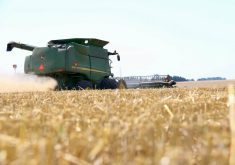CNS Canada — Canola futures on the ICE Futures Canada trading platform were slightly weaker during the week ended Wednesday, but managed to hold up better than the Chicago soybean market.
Worries about flood damage to canola crops in parts of southwestern Manitoba and southeastern Saskatchewan prevented prices from dropping as far as soybeans during the week, but won’t likely provide much more support for canola.
“The problem with the situation right now is the soybeans going down, and the market is so bearish on the beans that regardless of the flood, we’re probably going to see some pressure on the ICE Canada futures,” said Errol Anderson of ProMarket Communications in Calgary.
Read Also

U.S. grains: Soybeans hit six-week low as Brazilian harvest looms; corn, wheat sag
Chicago | Reuters – Chicago soybean futures fell to six-week lows on Friday as worries about slowing export demand for…
“It’s unfortunate it’s in such great shape because if the U.S. was threatened, canola, quite honestly, would be probably going through quite a rally right now,” he added.
As long as soybeans keep falling, canola will eventually start to drop along with them. According to Anderson, the next level of support for US soybean futures is at US$10.80 per bushel in the November contract, which would be about US24 cents below Wednesday’s settlement.
“That in itself would push the canola down towards C$440 per tonne,” Anderson said. “And then if this thing got really ugly and the November beans broke 10 bucks, which a number of American analysts are suggesting, then we’re probably heading down to C$400 on the November canola.”
Though the futures market is expected to see a significant drop if soybean futures continue to break, the cash market may hold up better as flooding worries in Western Canada result in a bullish basis outlook longer-term, said Anderson.
The 2014-15 carryout stocks of canola will likely be a lot lower than first anticipated because of the lost production, he added. It will likely be a few weeks before the full extent of the damage is known, and Statistics Canada’s first production estimates in late August will give a better idea of how big the 2014-15 Canadian canola crop will be.
“I know some people are very hard hit, but with floods it’s amazing how there’s a degree of recovery over time,” Anderson said. “So there will be some crop coming for sure. And then there are parts of the prairies that are in perfect shape.”
— Terryn Shiells writes for Commodity News Service Canada, a Winnipeg company specializing in grain and commodity market reporting.















